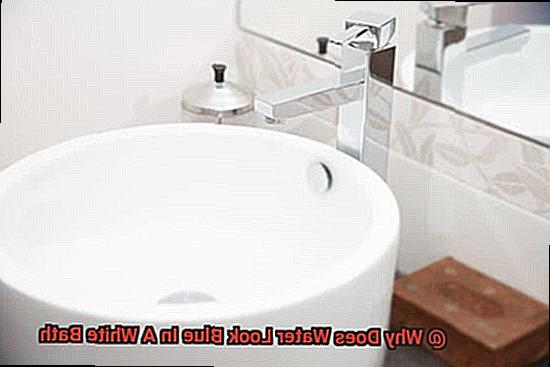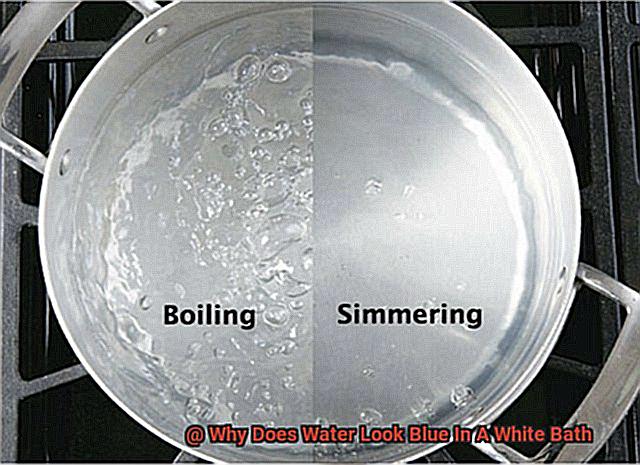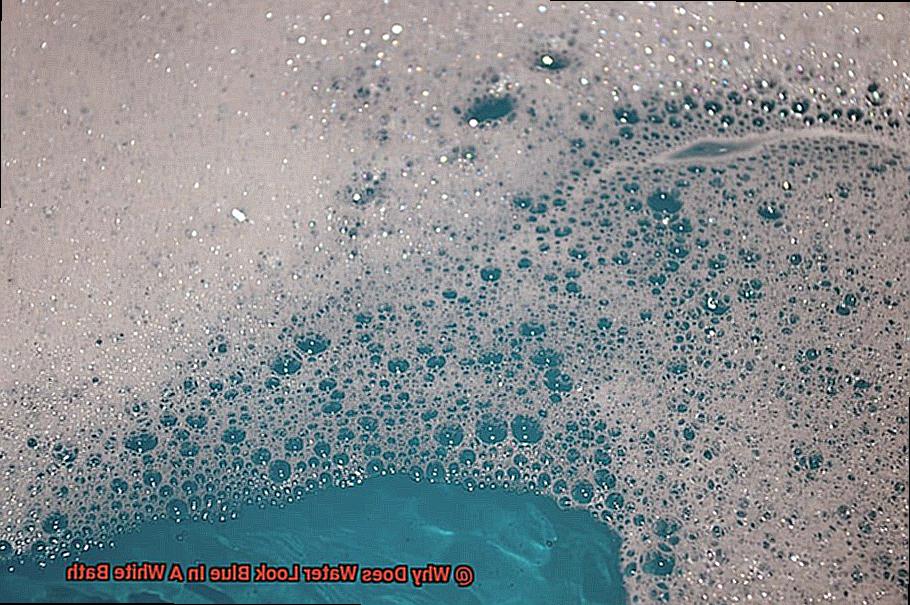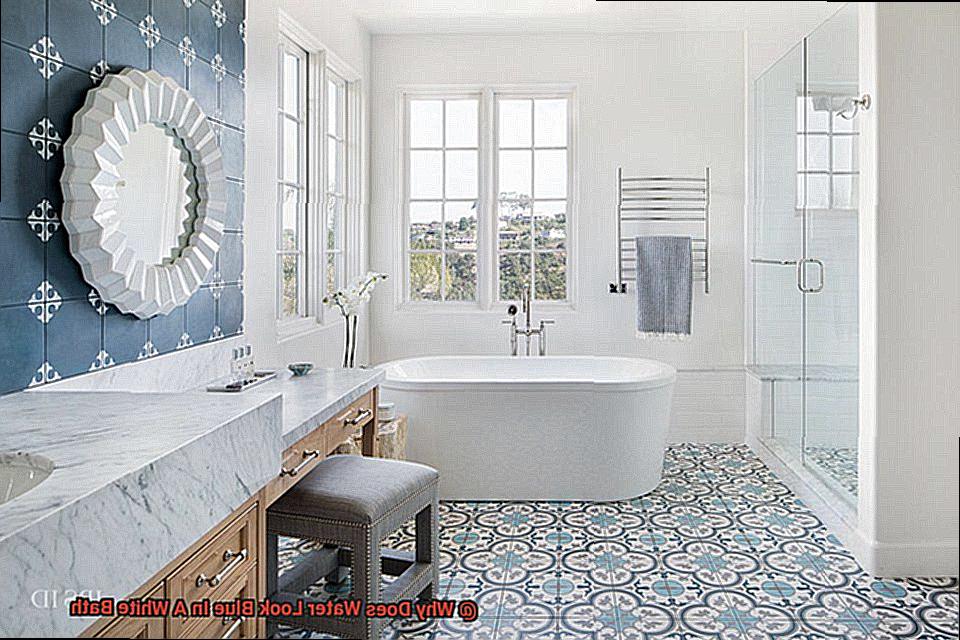Contents
- 1 The Natural Blue Tint of Water Molecules
- 2 Reflection of Surrounding Light
- 3 Contrast with the White Bath
- 4 How Does This Affect DIY Enthusiasts?
- 5 Enhancing the Bathing Experience
- 6 The Science Behind Water and Light Interaction
- 7 Understanding the Properties of Water
- 8 Exploring Different Color Schemes for Your Bathroom
- 9 Conclusion
The Natural Blue Tint of Water Molecules
Water molecules are made up of two hydrogen atoms and one oxygen atom arranged in a V-shape. When light passes through water, it is absorbed by the water molecules. The amount of light absorbed depends on the wavelength of the light; shorter wavelengths, such as blue and violet, are absorbed more than longer wavelengths like red and orange.
As a result, when we observe water from a distance, it appears skewed towards the blue end of the spectrum. Additionally, water molecules also reflect light back towards our eyes, with this reflection also skewed towards the blue end of the spectrum due to the absorption of other colors. This explains why we see a beautiful blue color when looking at large bodies of water.

In a white bathtub, this same principle applies. The water molecules in the bathtub have a natural blue tint due to their absorption and reflection of light. When this water is viewed against a white background, such as the porcelain of a bathtub, the blue color becomes more noticeable.
However, it’s important to note that other factors can also affect the color of water in a bathtub or any body of water. Impurities such as algae or minerals can change the color to green or brown, while reflections from surrounding objects can also alter color perception.
Understanding the natural blue tint of water molecules and how they interact with light can help us appreciate the science behind everyday occurrences in our lives.
Reflection of Surrounding Light
Before, we learned that water molecules tend to absorb colors from the red end of the spectrum more efficiently than they do from the blue end. This means that when white light enters water, red light is absorbed quickly while blue light is scattered and reflected back to our eyes, giving water its distinctive blue hue.
But did you know that the color of water can also be influenced by the reflection of surrounding light? If you are taking a bath in a room with blue walls or tiles, for example, this can reflect onto the surface of the water and give it a slightly bluish tint. It’s like having your own personal color palette.
Moreover, the color of water in your bath can also be affected by the reflection of sunlight or other sources of light around you.
On a cloudy day with less direct sunlight, the water may appear darker and deeper due to the absence of reflected light.

Similarly, if you have a window in your bathroom that lets in natural light, this can also impact the color of your bathwater.
Contrast with the White Bath
The blue color of water in a white bathtub can be attributed to a few different factors. Firstly, the water itself may contain minerals or impurities that give it a blue tint. But that’s not all. The reflection of light off the white surface of the bathtub can also contribute to this effect. When light is reflected off the surface of the water, it can pick up some of this blue coloration, creating a beautiful bluish hue.
But let’s dive deeper into the science behind this. Water molecules absorb and scatter light differently depending on its wavelength. When white light enters water, the shorter, more energetic wavelengths (such as blue and violet) are absorbed more strongly than longer wavelengths (such as red and orange). This means that the blue wavelengths are scattered more throughout the water, making it appear blue in color.
So, when you combine the reflection of blue light off the surface of the water with the scattered blue light throughout the water, you get a mesmerizing blue hue in your bathtub. This effect is particularly noticeable against the white background of the bathtub.
But why stop there? By understanding these factors, homeowners can appreciate and even enhance this effect by choosing complementary bathroom decor and lighting schemes. Imagine adding some blue accents to your bathroom to highlight this stunning effect.
In conclusion, there are many scientific explanations for why water appears blue in a white bathtub. From minerals and impurities in the water to the way light behaves when it passes through and reflects off water molecules, there’s a lot at play here.
How Does This Affect DIY Enthusiasts?
When it comes to choosing the right cleaning products, knowing the science behind the bluish tint in your bathwater can make all the difference. Instead of using harsh chemicals that may damage your tub’s surface, you can opt for milder cleaning solutions that will do the job without causing any harm. By doing so, you can keep your bathroom looking its best without compromising its integrity.
But that’s not all – understanding why water looks blue in a white bath can also help you identify potential plumbing issues. If you notice that the water in your bathtub is consistently darker than usual, it may indicate a problem with your water supply or pipes. Armed with this knowledge, you can make informed decisions about when to call a professional for assistance, saving time, money, and frustration in the long run.
So next time you’re tackling a bathroom project, keep this knowledge in mind. By utilizing your understanding of the science behind why water looks blue in a white bath, you can make informed decisions about cleaning products and plumbing issues, ensuring that your bathroom remains clean, fresh, and functional for years to come.
Enhancing the Bathing Experience
Look no further. Enhancing the blue color of water in a white bathtub can be accomplished with just a few simple steps. Let’s dive in and explore how we can make the most out of our bath time.
To begin with, let’s understand why water in a white bathtub often appears blue. Water has a natural blue tint, which is more visible in large bodies of water. When light enters the water, it gets scattered in every direction by the molecules in the water. Since blue light travels as shorter, smaller waves, it gets scattered more than other colors, giving water its blue appearance.
Now that we know why the water looks blue let’s discuss how we can enhance this effect. Adding bath salts or essential oils with a blue hue can elevate the blue tint of the water and create a visually appealing atmosphere. These additives can also have added benefits such as relaxation, stress relief, and better skin health. How about some lavender-scented bath salts with a hint of blue color? Sounds heavenly.

Another way to enhance your bathing experience is by adding LED lights to your bathtub. These lights can be programmed to change colors and create a calming ambiance that enhances the overall bathing experience. Imagine soaking in your bathtub while being surrounded by soft blue light and listening to your favorite music – talk about ultimate relaxation.
Understanding why water looks blue in a white bathtub can help us create an atmosphere that promotes relaxation and calmness. By adding elements like bath salts, essential oils, or LED lights that deepen or enhance the blue color, we can elevate our bathing experience to new heights.
The Science Behind Water and Light Interaction
You might be wondering how this happens. Well, it all comes down to the fascinating science behind the interaction between light and water.

Water molecules can absorb light in the red end of the spectrum, but not in the blue end. When white light enters a body of water, it interacts with the water molecules, getting scattered and absorbed. The shorter wavelengths, including blue and violet, get scattered more than longer wavelengths such as red and orange. And this scattering effect is known as Rayleigh scattering.
So, when you see blue water in your bath or even in the ocean, it’s because the blue part of the spectrum has been scattered more than any other color. This is also why we see beautiful blue skies on a clear day – shorter wavelengths of light are scattered in all directions by the Earth’s atmosphere.
It’s important to note that there are other factors that can affect water’s color too. Algae and microscopic organisms can give water a green or brown tint, while sediments and pollutants can alter its appearance too. However, if your bathwater appears blue in a white tub filled with clean tap water, Rayleigh scattering is most likely the cause.
Next time you take a bath or go swimming and notice the serene blue color of the water, remember that it’s not just a visual treat but also a result of an intriguing scientific phenomenon. Thanks to Rayleigh scattering, we can appreciate the beauty of blue water not just in our baths but also in nature.
Understanding the Properties of Water
Water is a wondrous substance, possessing many unusual properties that make it essential to life on Earth. One of its most captivating features is its ability to appear blue in a white bath or the ocean. This stunning phenomenon is due to the way water interacts with light.
When white light enters water, it undergoes dispersion, a process that bends and separates the light into different colors. The color blue, with its short wavelength, is refracted more than other colors when light enters water. As a result, blue light is scattered more throughout the water, giving it a cool bluish tint. This effect, known as Rayleigh scattering, is also responsible for the serene blue sky we see during the day.
However, water’s color can also be influenced by impurities like minerals or organic matter that absorb certain colors of light and reflect others. For instance, iron compounds can give water a yellowish-brown tint, while algae can make it appear green.
Water possesses many other unique physical characteristics that make it indispensable to life. Its high heat capacity allows it to absorb and release heat without experiencing significant temperature changes. As a result, water is an excellent choice for regulating body temperature and maintaining homeostasis.
Exploring Different Color Schemes for Your Bathroom
Designing your bathroom should be an exciting process, but choosing the right color scheme can elevate the overall ambiance of the room and make all the difference. While white may be a popular choice for bathroom fixtures and tiles, adding pops of color can create a space that feels cohesive and inviting.
Here, we’ll explore different ways to choose a color scheme that reflects your personal style and enhances your daily routine.
Using a color wheel is a great place to start exploring different color schemes. It’s a tool that shows the relationship between colors and can guide your choices. Complementary colors, which are opposite each other on the wheel, can create a bold and dramatic effect, while analogous colors, which are next to each other on the wheel, can create a harmonious and calming effect.
Choosing a color scheme using the color wheel will ensure that you have a balanced look in your bathroom.
Another way to choose a color scheme is by considering the mood you want to create. For example, blues and greens can create a calming and spa-like atmosphere, while warm tones like yellows and oranges can create a cozy and inviting feel.
You need to choose colors that make you feel comfortable and relaxed in your space. Think about what makes you happy and what helps you unwind after a long day.
In addition to choosing a color scheme, it’s important to consider the finishes of your bathroom fixtures and accessories.
Chrome or brushed nickel finishes can add a modern and sleek touch, while brass or copper finishes can add warmth and a vintage feel. Mixing finishes can also add visual interest and depth to your space. So don’t be afraid to experiment with different combinations.
When exploring different color schemes, don’t shy away from experimenting with various shades and tones. Soft pastels or bold jewel tones can create a unique look that reflects your personal style.
And remember, adding color doesn’t have to be permanent – you can incorporate pops of color through accessories like towels, rugs, or shower curtains. These can be easily swapped out if you want to try a new color scheme.
Exploring different color schemes for your bathroom can be a fun and creative process that allows you to design a space that reflects your personal style and enhances your daily routine.
EJw63VAnJx4″ >
Conclusion
To sum it up, the magic behind the blue hue of water in a white bath is nothing short of captivating. It’s a complex interplay of scientific factors such as Rayleigh scattering and light reflection that contribute to this breathtaking phenomenon.
But it’s not just about understanding the science; it’s about enhancing our daily experiences with complementary colors, lighting schemes, and relaxing additives like bath salts and essential oils.
Moreover, having a grasp of these principles can help us make informed decisions when it comes to cleaning products and plumbing issues. This ensures that our bathrooms remain functional and visually pleasing for years to come.
And let’s not forget about designing our bathrooms. By using tools like a color wheel, we can create a space that reflects our personal style while enhancing our daily routine.
In essence, whether we’re luxuriating in a bathtub or taking a dip in nature’s blue waters, appreciating the science behind this phenomenon adds an extra layer of awe and wonder to our lives.





